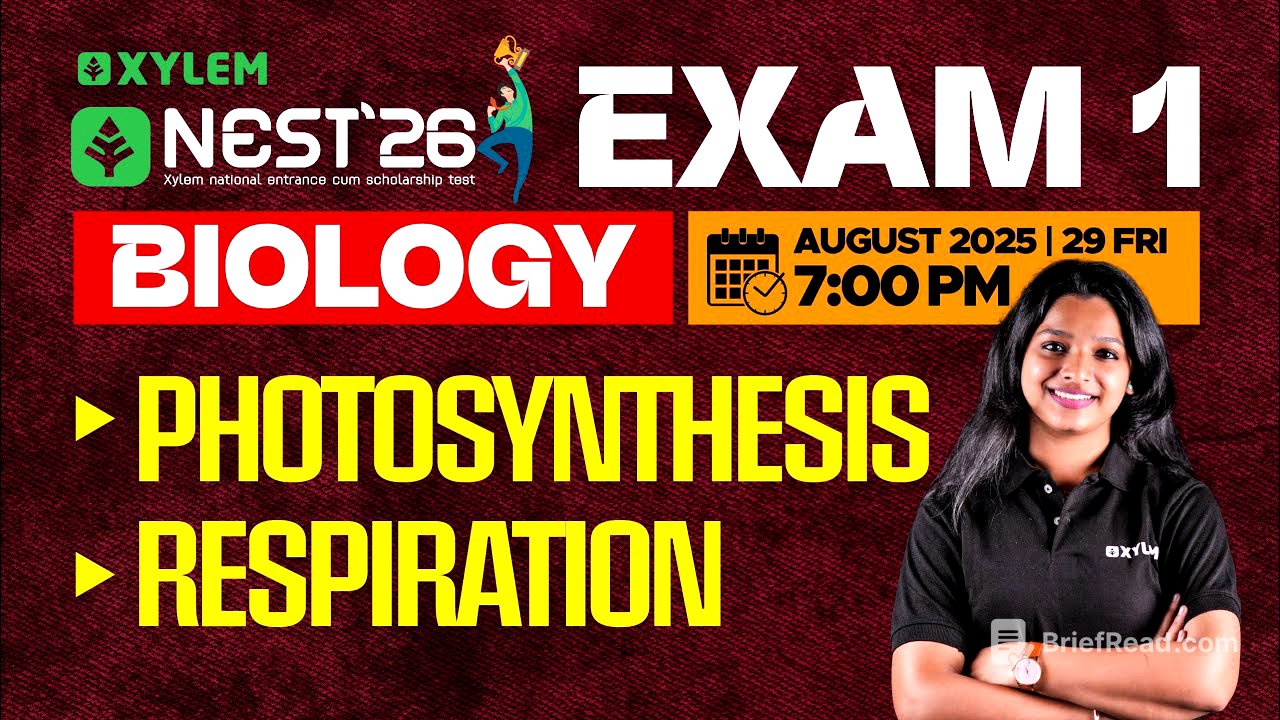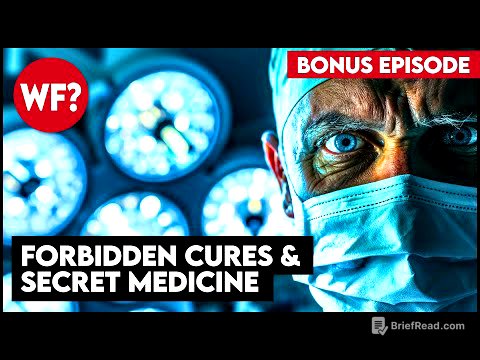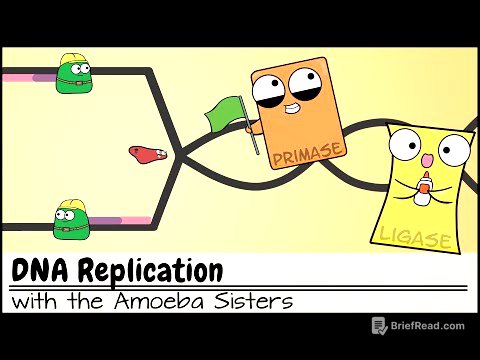TLDR;
This video is a biology lesson geared towards students preparing for the NEET exam, covering key concepts in nutrition, photosynthesis, and respiration. The instructor reviews the exam format, syllabus, and provides problem-solving techniques. The lesson emphasizes understanding the differences between autotrophic and heterotrophic nutrition, light and dark reactions in photosynthesis, and aerobic and anaerobic respiration.
- Examines NEET exam format and syllabus.
- Explains autotrophic and heterotrophic nutrition.
- Details photosynthesis, including light and dark reactions.
- Covers aerobic and anaerobic respiration.
Introduction [0:02]
The session starts with a warm welcome to students, setting the stage for a biology class focused on NEET preparation. The instructor emphasizes the importance of taking the first step towards achieving their dreams through this class. The class aims to address doubts and provide clarity on the topics relevant to the NEET exam.
NEET Exam Overview [0:51]
The instructor provides an overview of the NEET exam, clarifying that it is a multiple-choice question (MCQ) based exam. The exam includes questions from Physics, Chemistry, and Biology, with Biology having a higher weightage. The total marks for the exam are 360, and it is essential to correctly fill the OMR sheet, as it is checked by a machine. Each question carries four marks, with a negative marking for incorrect answers.
Syllabus Introduction [7:54]
The instructor introduces the biology syllabus, which includes topics such as sense organs, neuron structure and function, photosynthesis, aerobic and anaerobic respiration, excretory system, and hormones. The class is designed to cater to students from both state and CBSE backgrounds, ensuring that the syllabus is covered comprehensively.
Photosynthesis Question [10:24]
The instructor presents a question from a previous year's exam, asking students where oxygen is released from during photosynthesis. The correct answer is water. This exercise aims to build confidence among students and encourage them to register for the upcoming NEET exam.
Nutrition: Autotrophic vs. Heterotrophic [13:08]
The lesson transitions to the topic of nutrition, differentiating between autotrophic and heterotrophic modes. Autotrophs, like plants and cyanobacteria, make their own food using inorganic substances such as carbon dioxide and water. Heterotrophs, including animals and fungi, depend on others for nutrition.
Autotrophic Nutrition: Photosynthetic and Chemosynthetic [20:29]
Autotrophic nutrition is further divided into photosynthetic and chemosynthetic types. Photosynthetic organisms use light as an energy source, while chemosynthetic organisms use chemical substances. Examples of chemosynthetic bacteria include Nitrosomonas and Nitrobacter, which convert inorganic nitrogen compounds into food.
Photosynthesis: Light and Dark Reactions [24:39]
The process of photosynthesis is explained in detail, emphasizing the roles of water, carbon dioxide, chlorophyll, and sunlight. The equation for photosynthesis is presented, highlighting the release of oxygen. The lesson then describes the two main phases of photosynthesis: the light phase (in the grana) and the dark phase (in the stroma). During the light phase, light energy is converted into chemical energy (ATP and NADPH), while in the dark phase, glucose is synthesized.
Photosynthesis in Detail [30:49]
The lesson further explains that photosynthesis occurs in the leaves of plants, specifically in the mesophyll cells, which contain chloroplasts. Chloroplasts have a double membrane and contain thylakoids arranged in stacks called grana. The fluid part of the chloroplast is called the stroma. The light reaction occurs in the grana, where light energy is converted into chemical energy, and water is split (photolysis) to produce oxygen, protons, and electrons. The dark reaction occurs in the stroma, where carbon dioxide is reduced to carbohydrates using ATP and NADPH.
Heterotrophic Nutrition [28:28]
Heterotrophic nutrition involves organisms utilizing components made or digested by others. Heterotrophs can be directly or indirectly dependent on autotrophs.
Review Questions on Photosynthesis [42:36]
The instructor presents review questions to reinforce the concepts learned. One question asks about the carbohydrate reserve of plants, with the correct answer being starch. Another question addresses how respiration occurs in the bark of trees, with the correct answer being lenticels.
Respiration: Definition and Process [46:49]
The lesson transitions to the topic of respiration, defining it as the process of converting food into energy. Cellular respiration involves breaking down glucose to produce energy in the form of ATP (adenosine triphosphate). ATP is referred to as the energy currency of the cell.
ATP: The Energy Currency of the Cell [50:35]
ATP is essential for various bodily functions, including muscle contraction, protein synthesis, and nerve impulse transmission. The structure of ATP is explained, highlighting the presence of adenine, ribose, and three phosphate groups. The breakdown of ATP releases energy, which is utilized by cells to carry out various processes.
Aerobic vs. Anaerobic Respiration [55:46]
Cellular respiration is categorized into aerobic and anaerobic types. Aerobic respiration requires the presence of oxygen, while anaerobic respiration does not. Anaerobic respiration includes alcoholic fermentation and lactic acid fermentation.
Aerobic Respiration: Glycolysis and Krebs Cycle [58:28]
Aerobic respiration involves two main steps: glycolysis and the Krebs cycle. Glycolysis occurs in the cytoplasm, where glucose is broken down into pyruvate. The Krebs cycle occurs in the mitochondria, where pyruvate is further broken down to produce carbon dioxide, water, and energy.
Review Questions on Respiration [1:04:57]
The instructor presents review questions on respiration, such as where the breakdown of pyruvate occurs to produce carbon dioxide, water, and energy (the answer is mitochondria). Another question asks where chlorophyll pigment is found (the answer is plastids).
Exam Preparation and Closing Remarks [1:08:37]
The session concludes with a reminder of the necessary items to bring for the exam, including the hall ticket, Aadhaar card, and pen. The instructor encourages students to study well, solve questions, and prepare thoroughly for the exam. The session ends with best wishes to the students for their future endeavors.







![BREAKING! DODGERS SHOCK MLB AND SIGN DOMINICAN STAR FOR THIRD BASE?! [Los Angeles Dodgers News]](https://wm-img.halpindev.com/p-briefread_c-10_b-10/urlb/aHR0cDovL2ltZy55b3V0dWJlLmNvbS92aS90Y1oxRF9vTHdNVS9ocWRlZmF1bHQuanBn.jpg)

